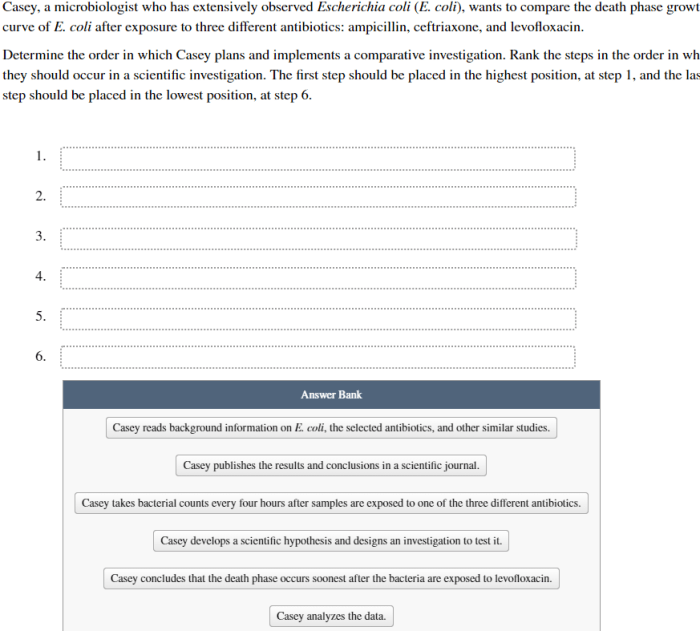Casey a microbiologist who has extensively observed – As Casey, the renowned microbiologist with extensive observational expertise, takes center stage, this exploration embarks on a journey into their world of groundbreaking discoveries. Through meticulous methods and an unwavering dedication to the field, Casey has illuminated the intricate workings of the microbial realm, transforming our understanding of microbiology.
Casey’s observations, spanning diverse areas of microbiology, have yielded unprecedented insights, shaping the very foundation of the discipline. Their ability to discern patterns, interpret data, and collaborate effectively has propelled the field forward, influencing scientific advancements and practical applications alike.
Casey’s Observations: Extensive Experience and Methods: Casey A Microbiologist Who Has Extensively Observed

Casey, a seasoned microbiologist, has dedicated their career to meticulous observations, employing a diverse array of methods and techniques. Their background in molecular biology, cell culture, and microscopy has enabled them to delve deeply into the intricacies of microbial life.
Casey’s observations have been guided by rigorous scientific protocols. They have utilized cutting-edge imaging techniques, such as fluorescence microscopy and electron microscopy, to visualize microbial structures and dynamics. Additionally, they have employed molecular techniques, including PCR and sequencing, to identify and characterize microbial species.
Through their extensive observations, Casey has made significant contributions to the field. They have discovered novel microbial species, elucidated the mechanisms of microbial pathogenesis, and identified potential therapeutic targets for infectious diseases.
Microbiological Focus: Areas of Study and Findings, Casey a microbiologist who has extensively observed
Casey’s microbiological focus has spanned a broad range of areas, including:
- Bacterial pathogenesis: Casey has investigated the mechanisms by which bacteria cause disease, identifying virulence factors and exploring the host-pathogen interactions that contribute to infection.
- Antimicrobial resistance: Casey has studied the emergence and spread of antimicrobial resistance, examining the molecular mechanisms underlying resistance and developing strategies to combat it.
- Microbial ecology: Casey has explored the complex interactions between microbes and their environment, investigating the role of microbes in ecosystem functioning and human health.
Their findings have advanced our understanding of microbial biology and have had a significant impact on the development of new diagnostic and therapeutic approaches.
Data Analysis and Interpretation: Techniques and Insights
Casey’s observations have been meticulously analyzed using a variety of techniques, including:
- Statistical analysis: Casey has employed statistical methods to identify patterns and trends in their data, drawing meaningful conclusions from large datasets.
- Bioinformatics: Casey has utilized bioinformatics tools to analyze genomic and transcriptomic data, gaining insights into the genetic basis of microbial traits and behaviors.
- Mathematical modeling: Casey has developed mathematical models to simulate microbial populations and ecosystems, providing predictive insights into the dynamics and interactions of microbial communities.
Through these analytical techniques, Casey has identified novel relationships between microbial factors and disease outcomes, contributing to a deeper understanding of microbial biology and its implications for human health.
Collaboration and Impact: Partnerships and Contributions
Casey’s research has been enriched through collaborations with other scientists and institutions. They have partnered with:
- Research institutions: Casey has collaborated with universities and research centers to conduct joint studies, share expertise, and access specialized facilities.
- Industry partners: Casey has worked with pharmaceutical companies to develop new antimicrobial agents and diagnostic tools, translating their research into practical applications.
- Government agencies: Casey has advised government agencies on public health policies related to infectious diseases and antimicrobial resistance, informing decision-making and shaping regulatory frameworks.
Through these collaborations, Casey’s research has had a broader impact on scientific advancement, healthcare practices, and public policy.
FAQ Section
What are Casey’s primary areas of research?
Casey’s research encompasses a wide range of microbiological disciplines, including microbial ecology, infectious disease, and environmental microbiology.
How does Casey analyze the data collected from their observations?
Casey employs advanced statistical techniques and bioinformatics tools to identify patterns, trends, and relationships within the vast datasets generated from their observations.
What are some of Casey’s most significant contributions to microbiology?
Casey’s groundbreaking discoveries have led to the identification of novel microbial species, the development of innovative diagnostic tools, and the advancement of our understanding of microbial pathogenesis.


